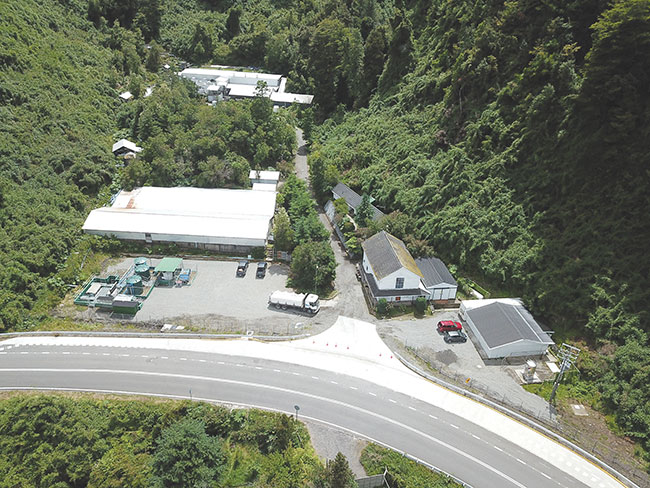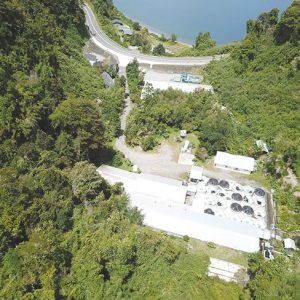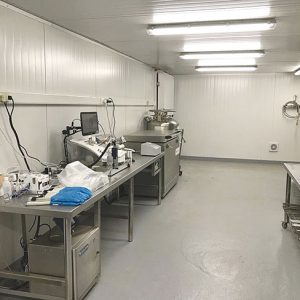
Features
Breeding
Business Management
Profiles
Benchmark Chile embarks on selective breeding
Ensenada hatchery ensures local supply of genetically improved salmon eggs
November 23, 2020 By Christian Pérez-Mallea
 Although the Ensenada hatchery was built in 1987, Benchmark Genetics Chile has heavily invested in instituting state-of-the-art technologies in the facility. (Photo: Benchmark Genetics Chile)
Although the Ensenada hatchery was built in 1987, Benchmark Genetics Chile has heavily invested in instituting state-of-the-art technologies in the facility. (Photo: Benchmark Genetics Chile) When Benchmark Genetics Chile took over operations of the Ensenada Hatchery in the middle of this year, it is with the intent of strengthening its position in the Chilean market for genetically improved salmon eggs.
Built in 1987 at the foot of the Osorno volcano, 76 km northeast from Puerto Montt and a few meters away from the Llanquihue Lake, Ensenada is an emblematic freshwater facility located in located in Las Cascadas. The facility formerly belonged to Pesquera Antares, a company that was subsequently purchased by salmon producing giant AquaChile in 1993.
Following its acquisition of the Ensenada facility, Benchmark Genetics Chile invested heavily on transitioning the hatchery into a state-of-the-art facility that includes a cryogenics laboratory.
Production capacity
The Ensenada facility includes a total tank capacity of 1,300 cubic metres intended for breeders. Its incubation units (Zoug jars) can hold about 75 million eggs, and about 200 tanks are dedicated for the different genetic families. Additionally, it has a spawning and fertilization room, as well as all the infrastructure needed for the screening of breeders.
Based on Benchmark Genetics Chile’s current business model the company is targeting to produce 50 million high-quality eyed eggs of their Chilean strain, according to the company’s general manager Pablo Mazo.
The Ensenada facility is responsible for the maintenance of broodstock, incubation of nuclei and multipliers, as well as maintaining groups of fry that will be used for research in developing resistance to pathogens, Mazo explains.
He adds, through genetic selection, the Chilean company is developing products that are both fast growers and disease resistant, particularly against the infectious pancreatic necrosis virus, Piscirickettsia salmonis, sea lice, and bacterial kidney disease.
“This will be available in the eggs that we will have for the year 2021. Soon (2022), we will also include resistance to HSMI (heart and skeletal muscle inflammation), which has already been challenged in our 2018 genetic cores,” Mazo says.
Responsible production
The Ensenada Hatchery houses a waste warehouses, with a necropsy room and an effluent treatment system. The site uses an flowthrough system and treats the effluent through mechanical filtration and UV disinfection.
“Our hatchery is supplied with first-use spring water of excellent quality, especially for the incubation of eggs. For that, we have water rights over a watershed that originates within the premises of this freshwater site,” Mazo says.
The Benchmark general manager explains the site operates under strict biosecurity control and procedures. The limited biomass production at the site, coupled with the effluent treatments and disinfection systems in place ensure a responsible operation that meets all requirements and regulations, he adds.
This is particularly important considering the large number of national parks, forestry reserves and other ecological tourist attractions in the area, including the Llanquihue Lake, which is the second largest in the country spanning 860 square kilometres.
This freshwater site has existed in the area and have become part of the environment for many years. “It is an installation that is on the edge of the road, but in an area where it is possible to co-exist with the natural heritage in a harmonious way and without risks to the biological balance of its environment. To ensure the latter, in addition to permanent supervision, we have procedures and contingency plans, which allow us to ensure and maintain a responsible and sustainable operation,” Mazo says.
He tells Hatchery International that his company is currently working to achieve the GLOBALG.A.P. standard certification, which will allow them to validate, raise and improve their operations in a manner that is environmentally responsible. GLOBALG.A.P. is an internationally recognized standard for farm production.
Cryopreservation explained
Pablo Mazo, general manager for Benchmark Genetics Chile, explains how his company is using cryopreservation to produce superior salmon eggs. The following is an excerpt of that conversation with this writer:
“The aquaculture sector is increasingly demanding highly specialized products with characteristics, such as resistance to pancreas disease (PD), bacterial kidney disease (BKD), against infectious pancreatic necrosis virus (IPN), piscine reovirus (PRV), piscirickettsia salmonis (SRS), cardiomyopathy syndrome (CMS) or resistance to caligus (sea lice).
Cryopreservation contributes to greater selection accuracy and, therefore, to greater steady and robust genetic progress. It is the tool that allows us to have these features available to our clients at the specific time they need it, since cryopreserved milt can be stored for several years in excellent conditions for use.
The principles of cryopreservation are relatively simple, but the technology and expertise required to carry them out efficiently is extremely complex and demands lots of teamwork and collaboration from our research scientists, production facilities, geneticists, and breeder experts. The technique basically consists of freezing and storing milt at -196 °C from pathogen-free males that show the highest and best performance in key traits (or ‘elite’ males). The milt is evaluated under strict quality control processes, before and after cryopreservation.
By using cryopreservation, we avoid relying on the natural spawning season or the quality of males available at that time to produce the best quality eggs. Our Ensenada cryopreservation laboratory provides our clients with the utmost precision in selection for key traits, availability and access to the best genetics, where and when they need it. The cryopreservation laboratory network – Benchmark Genetics Cryolabs – has been established in connection with our eggs and breeders production sites in Norway, Iceland and Chile.
We have been using cryopreservation in Europe for several years with many and particularly good results, achieving total control of the genetic material and its selection. The creation of Benchmark Genetics Cryolabs makes possible the optimal use of the milt of the best males in our genetic program and allows the use of milt from the same male for various fertilizations, allowing flexibility and optimization in production. Establishing our own biobanks ensures that we are in full control of genetic material and significantly reduces the risk of disease outbreaks.”
Print this page
Advertisement
- Anue Water presents new odor elimination system
- Monosex fish might help to address invasive species, researchers say







